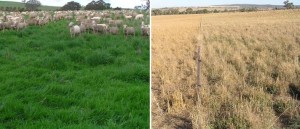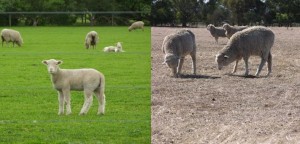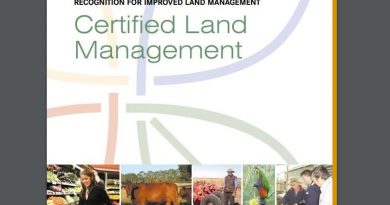AWI and MLA missing the phosphorus fertiliser point
By Patrick Francis
Australian Wool Innovations and Meat & Livestock Australia’s recent announcement of three projects to investigate phosphorus fertiliser use on sheep farm once again is missing the real issues involved. Individual projects run independently of the whole grazing system are characteristic of the silo thinking associated with many of two organisations on-farm research.

Improving on the abysmal phosphorus balance efficiency on sheep farms of around 20% (see Patrick Francis Australian Farm Journal May 2012) requires a holistic approach to the grazing systems being employed. Multiple factors are associated with phosphorus use by plants including:
* previous fertiliser application rates, and knowing levels of available and total P
* soil health, particularly the status of labile carbon percentage to improve soil water holding capacity and to maintain a prolific soil food web throughout the year and especially across prolonged dry and wet periods.
* types of grazing system employed and recovery for plants allowed especially after rainfall – set stocking versus time controlled grazing,
* types of pastures, species diversity and proportions of species – annuals versus perennials and percentage ground cover retained throughout the year,
* destocking strategies before critical soil health and pasture plant deterioration thresholds are met.
All these need to be understood in a holistic way irrespective of farmers allegiances to biological, organic or conventional management; they are not exclusive even though some advisors in these different sectors want them to be.
The new projects look like the same old tired approaches are being employed when AWI Head of On-Farm research Jane Littlejohn refers to “…devising new methods of testing for P”. On this point it would be more useful to suggest to farmers to gain a better understanding of existing P levels and devising P budgets for paddocks and soil types related to imports and exports of the nutrient. Surveys in NSW in recent years demonstrate most sheep farmers do not know paddock P levels and do not undertake P budgets. As phosphorus fertiliser is so expensive and is likely to be present in excess levels in farming districts as a result of decades of inefficient application, this would be the first requirement for changing attitudes.
Next Littlejohn says a project will examine the different abilities of plant species to utilise phosphorus to find out which are the most efficient. Not only is this a highly speculative approach because it ignores the points above but even if a more “P efficient” variety is found it will add to farm costs associated with planting with no guarantees about persistence across soil types, pests, grazing regimes and variable rainfall conditions. Developing new varieties (or other inputs like pesticides) is a common strategy used by contemporary Research and Development corporations in their quest for silver bullet solutions that appeal to some farmers. Such research is far simpler and less expensive than the extension effort required to identify underlying causes associated with systems failures such as unacceptably poor phosphorus fertiliser utilisation.
The AWI/MLA second P project “seeks to develop low P pasture systems that are capable of slowing the rate at which P accumulates in soil”. Such a system is already well known it’s called holistic grazing. Farmers using this system require very little phosphorus fertiliser input because their paddock soil food web is looked after 12 months of the year and especially through prolonged drier than average periods. On Moffitts Farm where holistic grazing is practiced no phosphorus fertiliser has been applied for 12 years, yet plant available P has remained above the recommended 15ppm every year since.

While some farmers continue to rely on pasture with a high proportion of sub clovers as the major contributor to autumn, winter and spring feed, the problem with phosphorus fertiliser use will continue. Sub clover is a shallow rooted species which requires an annual injection of available phosphorus to be productive.
The third project which “aims to increase the level of understanding of how phosphate reacts in the soil” is difficult to comprehend given 70 years of agricultural research inAustraliawith much of it devoted to basic and applied soil phosphorus research. What farmers need more understanding of is how different pasture and grazing system compare for productivity in conjunction with improving farm environmental outcomes.
This AWI/MLA research announcement is a knee jerk response to a soil health issue which has existed and been ignored in the winter spring dominant rainfall sheep grazing zone for decades. Phosphorus fertiliser use has been excessive and relatively unproductive at 20% use efficiency. These projects will do little to change the status quo as many farmers grazing systems needs re-evaluation as to the fundamental causes behind inefficient phosphorus fertiliser use.
Phosphorus facts from MLA
480kt (kilotonnes) of P is used in Australia annually (prior to the recent droughts)
450kt is used in agriculture
25% average efficiency for P applied as fertiliser across all agriculture in Australia
75% accumulates in soil with a small amount lost to waterways
20–40% P efficiency in grazing
45–60% P efficiency in cropping
POST SCRIPT 16 February 2013
Little change in MLA’s concept of soil fertility
By Patrick Francis
Meat and Livestock Australia has released the results of a review it initiated “to seek a deeper understanding of the key significant on-farm tactical and strategic decision areas that lead to more efficient use of resources for meat production, and specifically those that could be enhanced through improved data/information collection”.
Two private consulting companies, CSIRO and The University of New England collaborated to undertake the review and their deliberations were recently released on the MLA web site.
Part of the review involved identifying “key on-farm tactical, strategic and operational decisions that will benefit from better data/information flows”. Number one on the list was optimising stocking rate.
According to the researchers the number of animals run per hectare is a major driver of farm productivity and profitability and the major determinant of the stocking rate is the quantity of feed grown.
“While the upper limit of growth is environmentally determined by the rainfall/length of growing season and is influenced by the pasture/herbage composition, whether or not this potential is reached depends on the soil physical and chemical characteristics and then on the method of grazing”.
The team then identified how it is possible to improve pasture production through soil fertility. What came as a surprise was the interpretation of fertility simply in terms of “correcting soil nutritional deficiencies/acidity problems etc (GPP/Triple P)”. There was no acknowledgement that soil fertility is associated with soil organic carbon level, composition of the SOC as well as soil microbial biomass (the soil food web present). Mineralisation of SOC and microbial biomass respiration are important contributors to plant available nutrients, ignoring them undermines any meaningful interpretation of soil fertility.
The project aimed to find alternative monitoring techniques for soil fertility compared to the standard and costly paddock coring method. In discussing the need to find this the researchers said “The nutrients of major concern are phosphorus, potassium and sulphur. Nitrogen is not widely used on beef and sheep properties currently but may have an increased role in the future in intensive grazing systems and should be considered.”
Another component of improving pasture productivity cited was weed management. Once again the appreciation of the topic was extremely limited – identifying weed populations then control them with herbicides. There was no coverage of possible causes for weed infestations or alternative strategies to herbicides.
“There are many situations where pasture weeds are scattered throughout a pasture. While they remain scattered, they have little impact on productivity, but often these weeds have the potential to spread rapidly and have a significant effect on pasture productivity and impose significant long term control costs. The dilemma faced by producers when addressing these scattered infestations, is whether to spot spray or spray the whole paddock. While spraying the whole paddock will ensure that the weeds are controlled, more chemical is used and there is generally collateral damage to the underlying pasture even when selective sprays are used. However, there are some weeds for which there are no selective sprays (eg serrated tussock) necessitating spot spraying (often with less than 100% effectiveness) or the complete renovation of the pasture”.
Find out more
The full report B.GSM.0004 Potential for information technologies to improve decision making for the southern livestock industries is available on the MLA web



